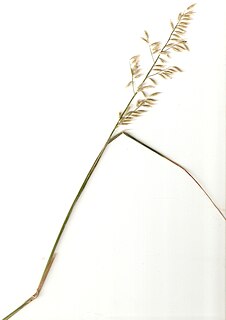Melica argyrea is a species of grass found in Argentina, Brazil, and Uruguay.
Melica argentata is a species of grass endemic to Chile.
Melica longiflora is a grass species in the family Poaceae that is endemic to Chile where it can be found from Coquimbo to Talca.
Melica brevicoronata, is a grass species in the family Poaceae that can be found in Brazil, southern South America, and Cerro Pan de Azúcar, Uruguay.
Melica bonariensis is a species of grass endemic to Argentina where it can be found in such provinces as Buenos Aires, La Pampa, and Rio Negro.
Melica brasiliana, is a grass species in the family Poaceae that is endemic to Brazil and southern South America.
Melica yajiangensis, is a species of grass that is endemic to China.

Melica violacea, is a species of grass in the family Poaceae endemic to Chile.
Melica serrana, is a species of grass endemic to Cerro de las Ánimas, Uruguay.
Melica stuckertii, is a grass species in the family Poaceae that is endemic to Argentina and southern South America.
Melica hyalina is a species of grass found in Brazil and southern South America.
Melica glabrescens is a species of grass found in Buenos Aires and Río Negro, Argentina.
Melica decipiens is a species of grass that can be found in the mountains of Cordoba and San Luis provinces of Argentina.
Melica lilloi is a species of grass found in Catamarca and Tucumán provinces of Argentina at 3,200–3,500 metres (10,500–11,500 ft) above sea level.
Melica kozlovii is a species of grass found on mountain slopes in Mongolia and China at 2,000–3,900 metres (6,600–12,800 ft) above sea level.
Melica paulsenii is a species of grass endemic to Chile where it grows along the coastal cordillera at 50–700 metres (160–2,300 ft) above sea level.
Melica mollis is a species of grass endemic to Chile where it grows in rock crevices at 340 metres (1,120 ft) above sea level.
Melica patagonica is a species of grass that is endemic to South America.
Melica parodiana is a species of grass found in Buenos Aires, Argentina and Uruguay.
Melica radula is a species of grass endemic to China. It grows on grassy mountain slopes and larch forests at 300–1,200 metres (980–3,940 ft) above sea level.
